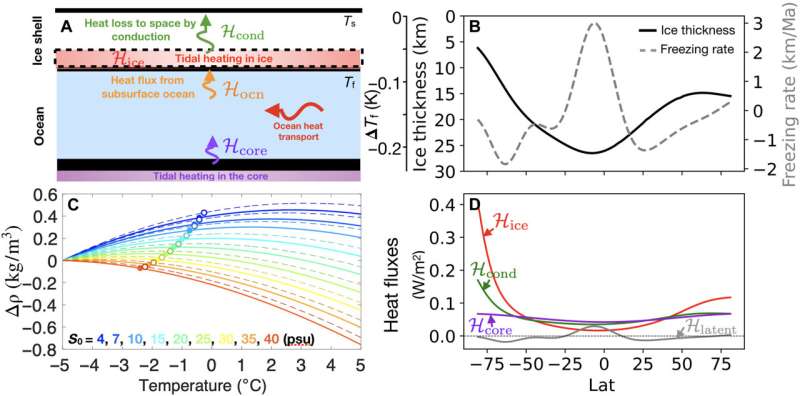July 25, 2022 report
Theoretical model suggests saltiness of Enceladus's oceans may be right to sustain life

A team of researchers at MIT has found via theoretical modeling that the saltiness of the oceans on Saturn's moon, Enceladus, may be the right level to sustain life. In their paper published in the journal Science Advances, the group describes the factors that went into building their model and the features of Enceladus that were used to measure the saltiness of its oceans.
The combined data from the Cassini and Galileo missions showed that Saturn's moon Enceladus and Jupiter's moon Europa both hold potential for satisfying three of the main features believed to be necessary for supporting life on other celestial bodies: they have a source of energy, they have liquid water and they have a mix of chemicals that prior research has shown is likely necessary for life. Geyser-like sprays from fissures near Enceladus' south pole are expected to provide an opportunity to learn more about the chemistry and dynamics of the ocean believed to exist beneath the moon's icy shell. In the meantime, space scientists continue to look at data from probes that have passed near the two moons to ascertain if either could possibly host life. In this new effort, the researchers used data from both probes to better understand the nature of the oceans trapped beneath icy shells.
Enceladus appears nearly pure white in photographs due to a layer of ice covering its entire surface. But the ice does have cracks and fissures, some with jets of water escaping to the surface. Prior researchers have suggested such water may contain organic matter that could support life. To learn more about the ocean beneath the ice, the researchers created a theoretical model—one based on data from Cassini and prior work that involved the study of ice formation on orbs using data regarding ocean currents, ice geometry and ocean salinity.
The model suggested that more salty oceans should correspond to thicker ice at the poles and less salty oceans to thinner ice at the poles. Data from Cassini has already shown that the ice over Enceladus's poles is thinner than the ice at its equator, suggesting that the saltiness of the ocean beneath the ice on the moon is low, perhaps as low as 30 grams per kilogram of water. For comparison, the saltiness of Earth's oceans is approximately 35 grams per kilogram of water. The model also showed possible current flow patterns beneath the ice based on temperature variations and possible evidence of heat vents on the ocean floor.
More information: Wanying Kang et al, How does salinity shape ocean circulation and ice geometry on Enceladus and other icy satellites?, Science Advances (2022). DOI: 10.1126/sciadv.abm4665
Journal information: Science Advances
© 2022 Science X Network




















